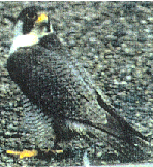|
Now nine years old, Pounce-Kingsley is the oldest known peregrine in Ontario and has with his mate Victoria raised 24 young over the past seven years. But his achievements as a father are all the more impressive in light of the challenges he overcame when younger...
At the end of the season, the site monitors evaluated each of the peregrines which had been released at Akron that summer. Though they felt that Pounce held some promise, he was not considered to be among the strongest of the group. This assessment seemed to ring true when he was spotted near the ground in a residential area of Windsor, Ontario in November of the same year, unable to fly. Pounce was brought to the Ontario Veterinary Clinic in Guelph, where he was found to be dehydrated and suffering from minor abrasions on his right wing and head. However, his most serious injury was a mid- shaft fracture of the right humerus. During surgery on November 27, a small plastic rod was inserted in the hollow of the bone to rejoin the two fragments. The procedure was successful, and Pounce spent the next two months resting and healing at the clinic. Toward the end of January, Pounce was brought to the Owl Foundation for rehabilitation. In recent years, injured peregrines have become regular visitors to the Owl Foundation, but at that time Pounce was quite an unusual guest. He was given a long flight cage in which to practice regaining his flight skills, and after a couple of months was deemed fit for release. On April 9, 1993 Pounce was brought to the nearby Beamer Conservation Area in Grimsby, where he was set free in front of an awestruck crowd of hawkwatchers. Where Pounce spent the following two years is something we will likely never know, as no sightings of him were reported during this period. Then, all of a sudden he reappeared in downtown Toronto in March 1995. At first he remained too distant for anyone to read his leg bands, so in the interim he became known as Kingsley in recognition of his choice of King Street as a home. When his background was learned, Pounce-Kingsley's hyphenated name became official. Together with his young mate Victoria, Pounce-Kingsley made history. The two eggs laid by Victoria around April 26 were the first ever for Toronto, and the first anywhere in southern Ontario in over forty years. By the end of May, two small fluffy chicks were visible in the nest, but to ensure that there was no possibility of disturbance, the news of this historic event was kept quiet until June 23 when the chicks were only a bit more than a week away from fledging. That day a front page story in the Globe and Mail introduced Pounce-Kingsley and Victoria to the world, and their fame has only continued to increase ever since. That first summer, office workers in Toronto often stopped by to watch the peregrines during lunch and coffee breaks. When a camera was installed overlooking the nest the following season, broadcasting to a street-level television monitor below, their fan base swelled even further. Then in 1997, with the arrival of the Toronto webcam, Pounce-Kingsley and Victoria became international celebrities. Following the 1995 nesting season, observers were delighted to see that Pounce-Kingsley and Victoria showed no signs of leaving their adopted home for the winter. In fact, they have remained in Toronto ever since, even through the harshest winters. Every year since 1996, they have produced at least three chicks, making them the most consistent breeding pair in Ontario. Though Pounce-Kingsley has taken some gentle criticism from observers for appearing to let Victoria do most of the work at times, he has always responded to the call of duty when needed, whether providing food for the chicks, giving flight lessons to the fledglings, or defending the territory against intruders (to which anyone who has had the misfortune of collecting the Toronto chicks for banding can attest). Pounce-Kingsley has not been forgotten by his home town either. In 1999, volunteers keeping an eye on his offspring during the annual Toronto fledgling watch were pleasantly surprised to be joined by several visitors from Akron, Ohio, who had made a trip north to see "their" bird as an adult. Already two of the peregrines raised by Pounce-Kingsley and Victoria have gone on to raise families of their own: Lucy this past spring in Ironton, Ohio, and Cabot-Sirocco in Rochester, New York for the past three years. As Pounce-Kingsley ages, it is uncertain how much longer he will reign over the downtown Toronto territory, though he has shown no signs of slowing down yet. Regardless of what the future holds for Pounce-Kingsley, he has already left a lasting impact on both the peregrine population and the people of Toronto. |

